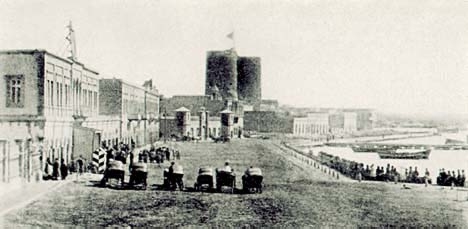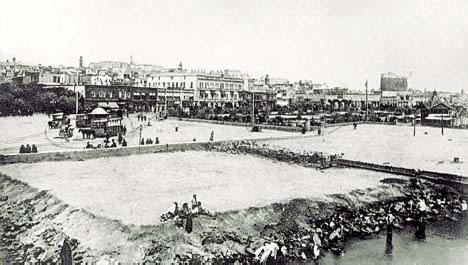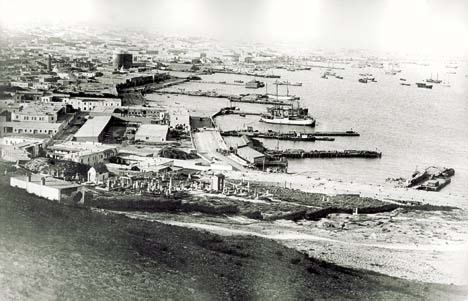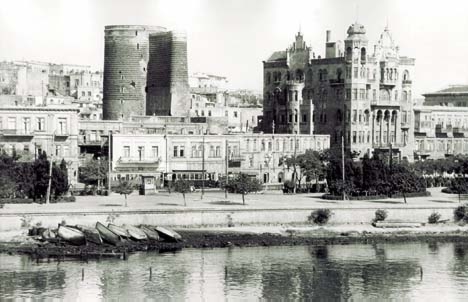|

Summer 2000 (8.2)
Pages
36-39
Seaside Boulevard
A Glimpse
Back Through History
by
Fuad Akhundov
Photos: Azerbaijan National Photo and Cinema Archives
  "The
Boulevard" is a promenade that runs parallel to Baku's seafront.
This area - popular for strolling and taking in views of the
Caspian - was recently named a national park. Its history goes
back more than 100 years, to a time when oil barons built their
mansions along the Caspian shore and when the seafront was artificially
built up inch by inch. "The
Boulevard" is a promenade that runs parallel to Baku's seafront.
This area - popular for strolling and taking in views of the
Caspian - was recently named a national park. Its history goes
back more than 100 years, to a time when oil barons built their
mansions along the Caspian shore and when the seafront was artificially
built up inch by inch.
Left: Divers performing at
the Baku Bathing House, early 20th century.
_____
As of 1806, the Maiden's Tower was only 5 to 10 meters away from
the Caspian Sea. However, as the Caspian receded, the land along
its shore was reclaimed. In 1884, the double fortress walls along
the sea surrounding Ichari Shahar (Inner City) were demolished
and construction began on one of Baku's first major avenues,
the Alexandrovskaya Naberezhnaya (Alexandrian Quay), which is
now known as Neftchilar Avenue (Oilmen's Avenue). The avenue
was designed to connect the oilfields in Bibi Heybat (south of
Baku) to the oil refineries in Black Town (to the northwest).
Artificial Seafront
Until the early 20th century, the avenue had mansions on one
side and seafront on the other. There were no trees. Tons and
tons of fertile soil were imported to enrichen the soil quality.
Baku's Mayor, R. R. Hoven, supported by the richest industrialists,
passed a decree in the 1880s saying that all ships entering Baku
harbors from Iran had to bring fertile soil with them. In reality,
this was a kind of "tax" or "duty" imposed
for the right to use the harbor and load up with oil. Within
a very short time, enough soil was deposited, and the parks that
characterize the city's seafront today were developed.

Photo: The sea front before
the Boulevard Park was built up. Maiden's Tower is in background.
In 1900, the Municipal Horticultural Commission decided to plant
trees and shrubs along the seafront. Kazimir Skurevich, a Polish
engineer, designed a 20-meter-wide embankment, using vegetation
that would survive Baku's extremely hot, dry and gusty climate.
The project was placed on reclaimed land near the Mir Babayev
residence (now the SOCAR building).

Photo: Plan for the Boulevard
Park, pre-Soviet period.
The next campaign to improve the Boulevard was launched in 1910
by Mammad Hassan Hajinski, Head of Baku's Municipal Construction
Department. At his urging, the Duma (Municipal Parliament) passed
a resolution to allocate 60,000 rubles to improve the promenade.
Adolph Eykler, a German architect who had also designed Baku's
German Lutheran Church (kirke), was involved in the project.

Photo: Building up the seafront
which is now the SOCAR circle.
Bathing House Built
To select the best design for the Boulevard, Hajinski organized
a contest among the architects in Baku. However, since most of
the city's 30 architects were busy designing mansions for oil
barons, only three submitted plans for it. The winning design
was titled "Zvezda" (Star) and featured a bathing house,
luxurious restaurant and a dozen pavilions. The design specified
that wastewater would be collected in a separate manifold instead
of being discharged directly into the Caspian (which unfortunately
is the case today). Work was completed in 1911.

Photo:
Building
up the quay. Ships coming to Baku to purchase oil were obliged
to exchange shiploads of soil to help build up the sea front.
At the new Baku Bathing House, visitors could take a swim while
visiting the Boulevard. Unfortunately, this bathing house was
closed in the late 1950s due to poor maintenance and the bay's
polluted water.

Photo: Maiden's Tower and
the Hajinski residence (built in 1912).
The improved Boulevard stretched from what is now the SOCAR Circle
to the luxurious cinema, restaurant and the casino that was called
"Phenomenon", designed by Polish architect Joseph K.
Ploshko (1912). During the Soviet period, the casino was converted
to a Children's Puppet Theater, a function it still serves today.
Subsequently, the Boulevard was extended up to the Port Arrival
Station. In the 1980s, the region was more or less mismanaged
and, as is true with most public spaces, maintenance was neglected.
The situation further disintegrated as the level of the sea began
to rise so high that many of the trees and shrubs in the park
started dying off due to the salinity of the water. Now, once
again, the Caspian sea level is going back down. The fact that
the Boulevard has finally been given the status of a National
Park brings hope that gradually the Boulevard will become the
vibrant park that it was originally intended to be more than
a century ago.
Fuad Akhundov, history enthusiast
who wrote this article, specializes in the architecture of early
20th-century Baku. Deep appreciation is also extended to Shamil
Fatullayev, Director of the Institute of Arts & Architecture
at the Academy of Sciences. Photos are courtesy of the National
Archives of Photo and Cinema Documents.
From Azerbaijan
International
(8.2) Summer 2000.
© Azerbaijan International 2000. All rights reserved.
Back to Index
AI 8.2 (Summer 2000)
AI Home
| Magazine Choice | Topics
| Store
| Contact
us
|






